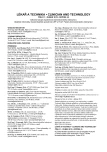-
Články
- Časopisy
- Kurzy
- Témy
- Kongresy
- Videa
- Podcasty
Non-destructive testing of artificial joints with defects by eddy current method
This work deals with non-destructive testing of artificial joints made from the austenitic steel SUS316L based on eddy current method. The technique is appropriate for final investigation of artificial joints before insertion the prosthesis into human body to avoid repeated operations. The most commonly implanted joints - knee and hip joint are evaluated in this study. The eddy current probe consists of one coil, which has both the excitation and sensing functions. Five detects are inspected using three different frequencies. The numerical simulations from Opera software with experiments are compared in this article to obtain the most appropriate frequency. The aim of this work is evaluation which frequency provides the biggest magnitude difference between individual simulated signals with various depths if surface defects are inspected.
Keywords:
artificial joints, austenitic steel, non-destructive testing, eddy currents
Autoři: Andrea Stubendekova 1; Ladislav Janousek 1
Působiště autorů: Department of Electromagnetic and Biomedical Engineering, Faculty of Electrical Engineering, University of Zilina, Zilina, Slovakia 1
Vyšlo v časopise: Lékař a technika - Clinician and Technology No. 1, 2015, 45, 5-9
Kategorie: Původní práce
Souhrn
This work deals with non-destructive testing of artificial joints made from the austenitic steel SUS316L based on eddy current method. The technique is appropriate for final investigation of artificial joints before insertion the prosthesis into human body to avoid repeated operations. The most commonly implanted joints - knee and hip joint are evaluated in this study. The eddy current probe consists of one coil, which has both the excitation and sensing functions. Five detects are inspected using three different frequencies. The numerical simulations from Opera software with experiments are compared in this article to obtain the most appropriate frequency. The aim of this work is evaluation which frequency provides the biggest magnitude difference between individual simulated signals with various depths if surface defects are inspected.
Keywords:
artificial joints, austenitic steel, non-destructive testing, eddy currents
Zdroje
[1] Výročná správa za rok 2011. [online], [2014/05/07], http://sar.mfn.sk/dokumenty.327.html
[2] Pernisova V., Capova K., Smetana M., Strapacova T., Biomaterial real defects evaluation using advanced detection sensors, ENDE 2013, Proceedings, ISBN 978-80-554-0713-5.
[3] Endoprotézy – kloubní náhrady, [online], [2014/05/07], http://www.lekari-online.cz/ortopedie/novinky/endoprotezy-nahrady
[4] Kreidl M., Šmíd R. Technická diagnostika, vyd. BEN-technická literatúra, Praha 2006. IBSN 80-7300-158-6.
[5] NDT Method Summary. [online], [2014/05/07], http://www.ndt-ed.org/GeneralResources/MethodSummary/MethodSummary.htm
[6] Kopec B. Nedestruktivní zkoušení materiálů a konstrukcí, vyd. Akademické nakladatelství CERM, Brno 2008. ISBN 978-80-7204-591-4.
[7] Rao, B. P. C. Practical eddy current testing. Alpha Science International Limited, 2007. ISBN: 978-1-84265-299-2.
Štítky
Biomedicína
Článok vyšiel v časopiseLékař a technika

2015 Číslo 1-
Všetky články tohto čísla
- EXPERIMENTAL MODAL ANALYSIS OF ULTRASONIC SURGICAL WAVEGUIDES USING EFFECT OF INVERSE MAGNETOSTRICTION
- Preliminary testing of flexible electrodes for biosignal measurement: abrasion resistance
- Utility of QRS isointegral maps in Left ventricular hypertrophy
- Přístupy ke sledování nákupů zdravotnických přístrojů
- Non-destructive testing of artificial joints with defects by eddy current method
- Lékař a technika
- Archív čísel
- Aktuálne číslo
- Informácie o časopise
Najčítanejšie v tomto čísle- Přístupy ke sledování nákupů zdravotnických přístrojů
- Non-destructive testing of artificial joints with defects by eddy current method
- EXPERIMENTAL MODAL ANALYSIS OF ULTRASONIC SURGICAL WAVEGUIDES USING EFFECT OF INVERSE MAGNETOSTRICTION
- Preliminary testing of flexible electrodes for biosignal measurement: abrasion resistance
Prihlásenie#ADS_BOTTOM_SCRIPTS#Zabudnuté hesloZadajte e-mailovú adresu, s ktorou ste vytvárali účet. Budú Vám na ňu zasielané informácie k nastaveniu nového hesla.
- Časopisy



